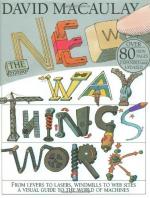|
This section contains 516 words (approx. 2 pages at 400 words per page) |

|
The New Way Things Work Summary & Study Guide Description
The New Way Things Work Summary & Study Guide includes comprehensive information and analysis to help you understand the book. This study guide contains the following sections:
This detailed literature summary also contains Topics for Discussion and a Free Quiz on The New Way Things Work by David Macaulay.
The New Way Things Work by David Macaulay is an illustrated book covering various topics in the categories of technology and mechanics. The book consists of four parts each of which which summarize a different aspect of mechanical science: simple machines, natural forces, light and sound waves, and electricity. The fifth section introduces computer technology and digital communication. It differs in that it has no introduction but includes the epilogue. Humor and the detailed hand drawn illustrations are accompanied by blurbs of text that break the large concepts into digestible amounts of information. A glossary of technical terms appears at the end of the book for the reader's further clarification.
Throughout the book the information is presented from different perspectives ranging from first person fictional accounts, to third person technical explanations, to diagrams which walk the reader through a process step by step. All the approaches compliment the central subject of that section to offer the reader various and diverse paths to understanding the information.
The first person accounts, narrated by a fictional inventor, appear throughout the book with a consistent font and illustrated earth tone cartoon background. The stories feature the inventor, his primitive but innovative and industrious people, and their domesticated woolly mammoths. These sections are the most narrative and sit above text that explains the technology or system being illustrated by the narrative. The technological text will include one or more clearly labeled diagrams illustrating the simple mechanics being demonstrated in the humorous mammoth story above.
Once a concept has been introduced, the author will spend several pages exploring instances where the mechanical concept is used.
Part One, Mechanics of Movement, covers different laws and properties of motion as they work in the simple machines that are the basis of all mechanical devices. Part Two, Harnessing the Elements, explores how the way in which molecules behave will effect the way a machine works. Part Three, Working With Waves, looks into the way in which waves of energy power everyday objects and extend the reach of our senses. Part Four, Electricity and Automation, introduces electrons, discusses machines which either produce or use electricity, and covers what happens when electricity is combined with movement.
Part Five is the final section on concepts and is an introduction to digital machines and systems. Entitled The Digital Domain & The Last Mammoth, it has a different structure from the previous sections. Instead of an introduction, it opens with a full cover mammoth story which introduces the concept of bits and binary code with a pumpkin metaphor. This is the only section which divides into designated chapters as opposed to subheadings. It includes a one page epilogue which gives conclusion to the mammoth story which has been used as a running illustration through the book.
The section following Part 5 is simply entitled "Eureka" and is an illustrated list of inventions categorized under the concepts they employ, and listed in the same order as they are introduced in the first five sections. A glossary of Technical Terms and an index make up the remainder of the book.
Read more from the Study Guide
|
This section contains 516 words (approx. 2 pages at 400 words per page) |

|



